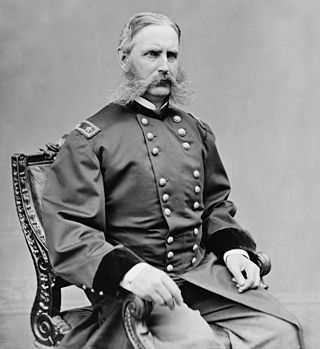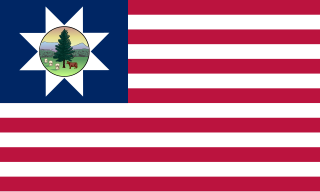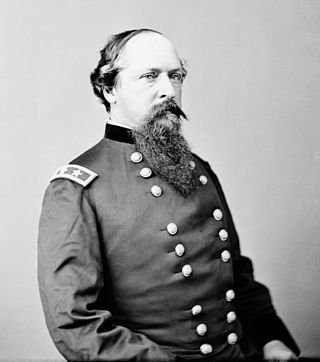Related Research Articles

John Cleveland Robinson was an American soldier in the United States Army. Robinson had a long and distinguished military career, fighting in many wars and culminating his career as a brigadier general and brevet major general in the Union Army during the American Civil War.

John Irvin Gregg was a career U.S. Army officer. He fought in the Mexican–American War and during the American Civil War as a colonel and near the end of the war as a brevet general in the Union army. In 1866, he was nominated and confirmed as a brevet major general of volunteers and a brevet brigadier general in the Regular Army, both to rank from March 13, 1865.

Christopher Columbus Augur was an American military officer, most noted for his role in the American Civil War. Although less well known than many other army contemporaries, he was considered an able battlefield commander.

The 2nd Vermont Infantry Regiment was a three years' infantry regiment in the Union Army during the American Civil War. It served in the eastern theater, predominantly in the VI Corps, Army of the Potomac, from June 1861 to July 1865. It was a member of the famous Vermont Brigade.

James Brewerton Ricketts was a career officer in the United States Army, serving as a Union Army general during the Civil War.

Asa Peabody Blunt was an officer in the Union Army during the American Civil War. He remained on active duty after the war. In recognition of his service during the Civil War, he was appointed to the grade of brevet brigadier general of volunteers. Blunt was notable as commander of the 2nd Vermont Brigade and the United States Disciplinary Barracks at Fort Leavenworth, Kansas.

Thomas West Sherman was a United States Army officer with service during the Mexican–American War and the American Civil War. While some contemporaries mistakenly identified him as the brother of the more famous General William T. Sherman, modern scholarship notes that the two were not closely related.

The Department of the Gulf was a command of the United States Army in the nineteenth and early twentieth centuries and of the Confederate States Army during the Civil War.

James Madison Robertson was a career United States Army artillery officer who commanded the First Brigade of U.S. Horse Artillery during the American Civil War.

James Allen Hardie was an American soldier, serving in a number of important administrative positions in the Union Army during the American Civil War.
The Department of Virginia and North Carolina was a United States Military department encompassing Union-occupied territory in the Confederate States during the Civil War. In 1863 it was formed by the merging of two previously existing departments: the Department of Virginia and the Department of North Carolina. In 1865 the two departments were once again separated.
The 11th Ohio Infantry Regiment was an infantry regiment in the Union Army during the American Civil War.
District of Arizona was a subordinate district of the Department of New Mexico territory created on August 30, 1862 and transferred to the Department of the Pacific in March 1865.

The Department of California was an administrative department of the United States Army. The Department was created in 1858, replacing the original Department of the Pacific, and it was ended by the reorganizations of the Henry L. Stimson Plan implemented in February 1913. As with the preceding organization, headquarters were in San Francisco. Its creation was authorized by General Orders, No. 10, of the War Department, Adjutant-General's Office, September 13, 1858.
Department of Florida, was the military administrative department established by the Union Army. The Department of Florida was established on April 13, 1861 to defend and administer the few remaining Federal installations remaining in Florida. Following the secession of Florida in January 1861, Florida troops seized most Federal property in the state with the exceptions of Fort Zachary Taylor at Key West and Fort Pickens at Pensacola. The Union Navy would use the port of Key West to establish a blockade of the Atlantic and Eastern Gulf coasts of the Confederacy, with the South Atlantic Blockading Squadron and the East Gulf Blockading Squadron.
William Walton Morris Jr. was an American soldier and a career officer in the United States Army. He served as a colonel and brevet brigadier general in the Regular Army, with Union Army service during the American Civil War (1861–1865). Morris served as a brigade commander primarily in charge of the defense of Fort McHenry and Baltimore Harbor. He had several brief periods in command of VIII Corps and of the Middle Department, which almost completely overlapped with each other.
The 102nd Pennsylvania Volunteer Infantry was an infantry regiment that served in the Union Army during the American Civil War.
The 12th Pennsylvania Reserve Regiment also known as the 41st Pennsylvania Volunteer Infantry was an infantry regiment that served in the Union Army as part of the Pennsylvania Reserves infantry division during the American Civil War.
The 40th Regiment, Massachusetts Volunteer Infantry Regiment was a three-year infantry regiment of the Union Army that served in the Department of Virginia and North Carolina, the Army of the Potomac, and the Department of the South during the American Civil War.
The Battle of Camp Davies was a skirmish during the American Civil War on November 22, 1863, near a Union Army camp about six miles south of Corinth, Mississippi. A 70-man detachment of the 1st Regiment Alabama Cavalry (Union), commanded by Major Francis L. Cramer, drove off a 150-man Confederate force of the 16th Battalion, Mississippi Cavalry State Troops, commanded by Major Thomas W. Ham, and killed at least 4 Confederate soldiers, while suffering two severely wounded troopers. This action is the only engagement recorded as occurring at or near Camp Davies in major sources on American Civil War battles. Other similar engagements in the vicinity of Corinth in 1863 may have occurred near Camp Davies.
References
- ↑ Frederick H. Dyer, A Compendium of the War of the Rebellion (New York: T. Yoseloff, 1959; originally published Des Moines, IA: The Dyer Pub. Co., 1908), Vol. 1, pp. 254–257
- Eicher, John H., & Eicher, David J., Civil War High Commands, Stanford University Press, 2001, ISBN 0-8047-3641-3.
- National Archives, Guide to Federal Records; Records of United States Army Continental Commands, 1821–1920 (Record Group 393), 1817–1940 (bulk 1817–1920)